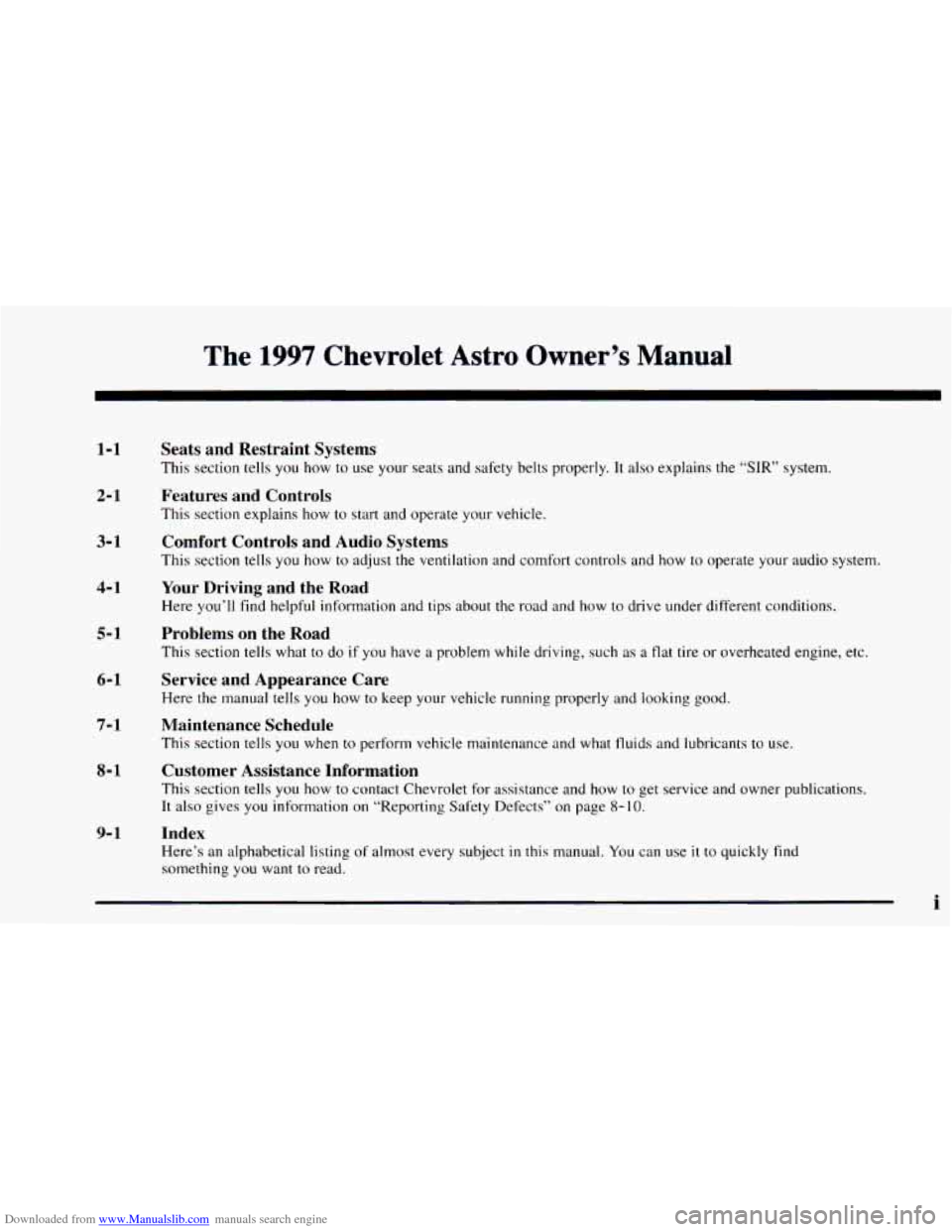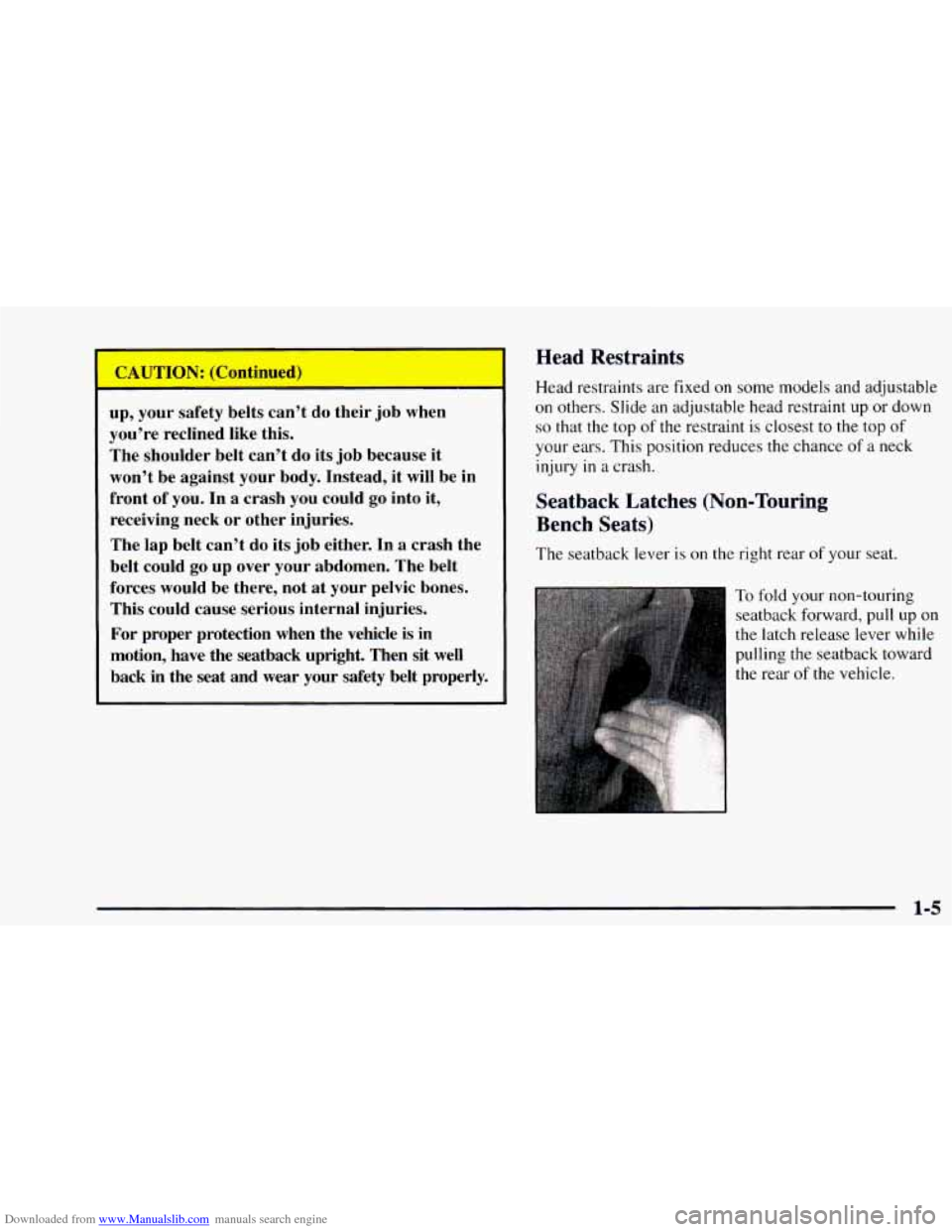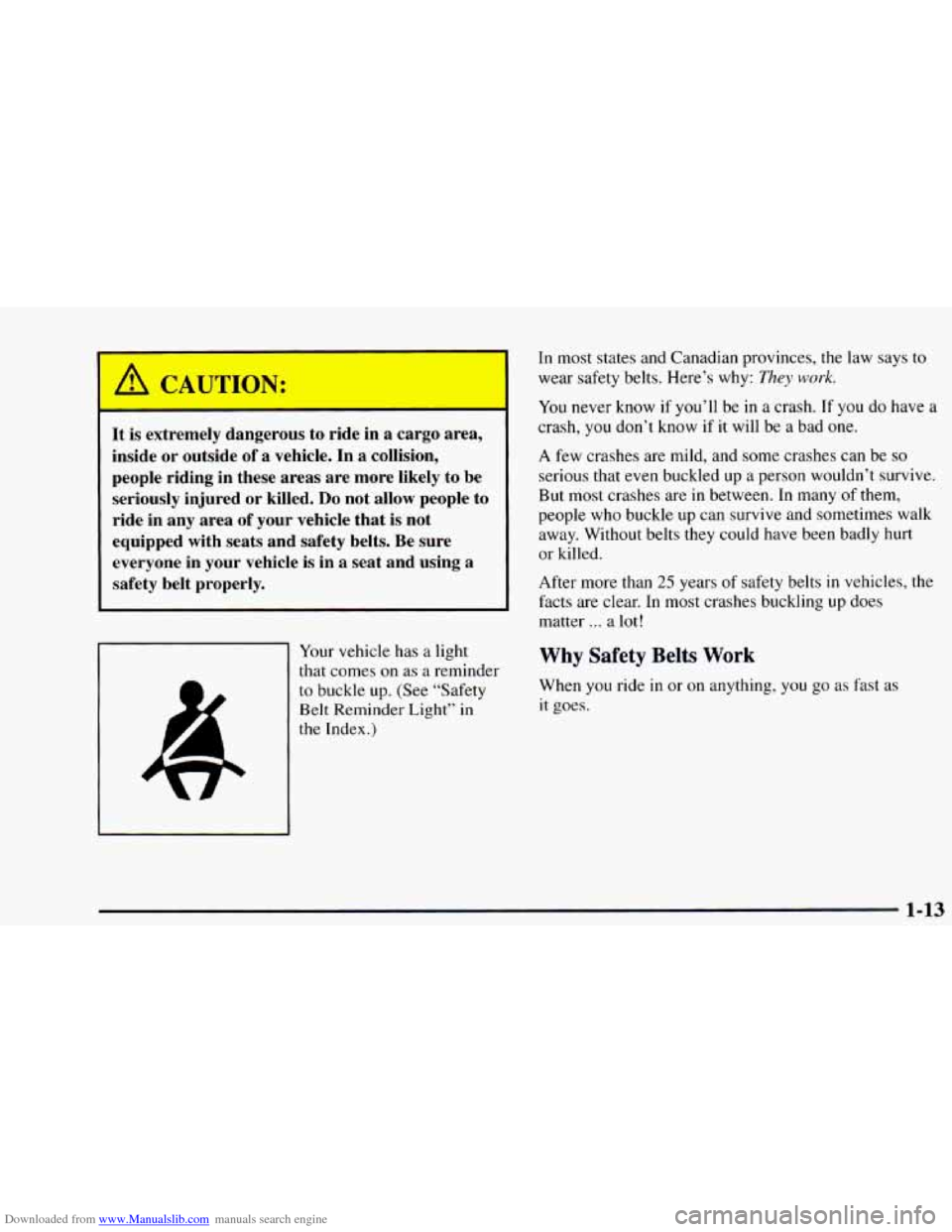Page 3 of 404

Downloaded from www.Manualslib.com manuals search engine The 1997 Chevrolet Astro Owner’s Manual
1-1
2-1
3- 1
4-1
5- 1
6-1
7-1
8-1
9- 1
Seats and Restraint Systems
This section tells you how to use your seats and safety belts properly. It also explains the “SIR’ system.
Features and Controls
This section explains how to start and operate your vehicle.
Comfort Controls and Audio Systems
This section tells you how to adjust the ventilation and comfort controls and how to operate your audio system.
Your Driving and the Road
Here you’ll find helpful information and tips about the road and how to drive under different conditions.
Problems on the Road
This section tells what to do if you have a problem while driving, such as a flat tire or overheated engine, etc.
Service and Appearance Care
Here the manual tells you how to keep your vehicle running properly and looking good.
Maintenance Schedule
This section tells you when to perform vehicle maintenance and what fluids and lubricants to use.
Customer Assistance Information
This section tells you how to contact Chevrolet for assistance and how to get service and owner publications.
It
also gives you information on “Reporting Safety Defects” on page 8-10.
Index
Here’s an alphabetical listing of almost every subject in this manual. You can use it to quickly find
something you want to read.
i
Page 7 of 404
Downloaded from www.Manualslib.com manuals search engine Vehicle Symbols
These are some of the symbols you may find on your vehicle.
For example,
these symbols
are used on an
original battery:
POSSIBLE A
CAUTION
INJURY
PROTECT EVES BY
SHIELDING
CAUSTIC
ACID COULD BATTERY
CAUSE
BURNS
AVOID
SPARKS
OR
FLAMES
SPARK
OR ,111,
COULD FLAME
EXPLODE BATTERY
These symbols are important
for you and
your passengers whenever your
vehicle
is
driven:
UNLOCK Esl
FASTEN
SEAT
BELTS
POWER
WINDOW
These symbols have
to do with
your lamps:
SIGNALS 6 e
TURN
FOG LAMPS
$0
These symbols
are
on some of
your controls:
WINDSHIELD
WIPER
WINDSHIELD DEFROSTER
WINDOW
DEFOGGER
These symbols are used
on
warning and
indicator lights:
COOLANT -
TEMP -
CHARGING BATTERY
SYSTEM
BRAKE
(0)
R.
ENGINE OIL w,
PRESSURE
ANTI-LOCK
(@)
BRAKES
Here are some
other symbols you may see:
FUSE
I
LIGHTER m
HORN )a(
SPEAKER
b
FUEL e3
V
Page 9 of 404
Downloaded from www.Manualslib.com manuals search engine Section 1 Seats and Restraint Systems
Here you’ll find information about the seats in your vehicle and how to use your safety belts properly. You can also
learn about some things
you should not do with air bags and safety belts.
1-2
1-12
1-17
1-18
1-18
1-26 1-27
1-27
1-34
Seats and Seat Controls
Safety Belts: They’re for Everyone
Here Are Questions Many People
Ask
About Safety Belts -- and the Answers
How to Wear Safety Belts Properly
Driver Position Safety Belt Use During Pregnancy
Right Front Passenger Position
Supplemental Inflatable Restraint (SIR)
System
Rear Seat Passengers
1-37
1-39
1-41
1-44
1-53
1-62
1-65
1-65
1-66 Rear Safety
Belt Comfort Guides
for
Children and Small Adults
Center Passenger Position
(Bench Seat)
Children
Built-in Child Restraint (Option)
Child Restraints
Larger Children
Safety Belt Extender
Checking Your Restraint Systems
Replacing Restraint System Parts After a
Crash
Page 13 of 404

Downloaded from www.Manualslib.com manuals search engine I-
up, your safety belts can’t do their job when
you’re reclined like this. The shoulder belt can’t do its job because it
won’t be against your body. Instead, it
will be in
front of you. In a crash you could
go into it,
receiving neck or other injuries.
The lap belt can’t
do its job either. In a crash the
belt could
go up over your abdomen. The belt
forces would be there, not at your pelvic bones.
This could cause serious internal injuries.
For proper protection when the vehicle is in
motion, have the seatback upright. Then sit well
back in the seat and wear your safety belt properly.
Head Restraints
Head restraints are fixed on some models and adjustable
on others. Slide an adjustable head restraint up or down
so that the top of the restraint is closest to the top of
your ears. This position reduces the chance of a neck
injury
in a crash.
Seatback Latches (Non-Touring
Bench Seats)
The seatback lever is on the right rear of your seat.
To fold your non-touring
seatback forward, pull
up on
the latch release lever while
pulling the seatback toward
the rear of
the vehicle.
Page 14 of 404

Downloaded from www.Manualslib.com manuals search engine After the latch has been released, push the seatback
toward the front
of the vehicle until it locks in place. To
raise the seatback, unlock the seatback latch by pushing
up on the lever while pushing down on the upper edge
of the seatback. Move the seatback into the upright
position. Make sure
the seatback is locked when it is
bacl 1 th lpright position.
A CAUTION:
If the seatback isn’t locked, it could move
forward in
a sudden stop or crash. That could
cause injury to the person sitting there. Always
press rearward
on the seatback to be sure it
is locked.
Rear Seats
A CAUTION:
A seat that isn’t locked into place properly can
move around
in a collision or sudden stop. People
in the vehicle could be injured. Be sure to lock
the seat into place properly when installing it.
A CAUTION:
- I
A safety belt that is twisted or not properly
attached won’t provide the protection needed in
a
crash. The person wearing the belt could be
seriously injured. After installing the seat, always
check to be sure that the safety belts are not
twisted and are properly attached.
1-6
Page 17 of 404
Downloaded from www.Manualslib.com manuals search engine Removing the Rear Seats
To remove the rear seats, do the following:
c I TO DETACH
‘1 BELT FOR
SEAT REMOVAL
-9.- I
INSERT KEY , 1
INTO HOLE
AND PUSH I
I I
1 I
1. If you are removing the
center seat, remove the
right lap-shoulder belt.
To do this, press the tip
of a key into the release
hole of the safety belt
attachment while pulling
up on the safety belt.
2. If you have a safety belt
guide on
your seat, pull
the
safety belt all the way
I, out through the guide.
3. Pull up on the seatback latch on the right rear of the
front seat. Push the seatback
down until it locks in
place (non-touring bench seats only).
1-9
Page 20 of 404

Downloaded from www.Manualslib.com manuals search engine 4. If you are replacing the center seat, connect the right
lap-shoulder belt to
the attachment on the seat
cushion. If
you have a safety belt guide on your seat,
pull the belt through
the guide before reattaching the
lap-shoulder belt to the side
of the seat. The release
hole should be facing outward.
If you installed the safety belt with the release hole
facing inward (toward the seat), slide the plastic
cover up
so you can see the buckle. Disconnect the
seat belt. Slide the cover back down and reinstall the
belt correctly.
NOTICE:
Be sure to put the correct seats back in the proper
positions
so the safety belts will work properly.
Safety Belts: They’re for Everyone
This part of the manual tells you how to use safety belts
properly. It also tells
you some things you should not do
with safety belts.
And it explains the Supplemental Inflatable Restraint
(SIR), or air bag system.
Don’t let anyone ride whel he or she can’t wear
a safety belt properly. If you are in a crash and
you’re not wearing
a safety belt, your injuries
can be much worse.
You can hit things inside the
vehicle or be ejected from it.
You can be seriously
injured or killed. In the same crash, you might
not be if you are buckled up. Always fasten your
safety belt, and check that your passengers’ belts
are fastened properly too.
1-12
Page 21 of 404

Downloaded from www.Manualslib.com manuals search engine I A CALION:
It is extremely dangerous to ride in a cargo area,
inside or outside
of a vehicle. In a collision,
people riding in these areas are more likely to be
seriously injured or killed.
Do not allow people to
ride in any area
of your vehicle that is not
equipped with seats and safety belts. Be sure
everyone in your vehicle
is in a seat and using a
safety belt properly.
Your vehicle has a light
that comes on as a reminder
to buckle up. (See “Safety
Belt
Reminder Light” in
the Index .)
In most states and Canadian provinces, the law says to
wear safety belts. Here’s why: They work.
You never know if you’ll be in a crash. If you do have a
crash,
you don’t know if it will be a bad one.
A few crashes are mild, and some crashes can be
so
serious that even buckled up a person wouldn’t survive.
But most crashes are in between. In many
of them,
people who buckle up can survive and sometimes walk
away. Without belts they could have been badly hurt
or killed.
After more than
25 years of safety belts in vehicles, the
facts are clear. In most crashes buckling up does
matter
... a lot!
Why Safety Belts Work
When you ride in or on anything, you go as fast as
it goes.
1-13